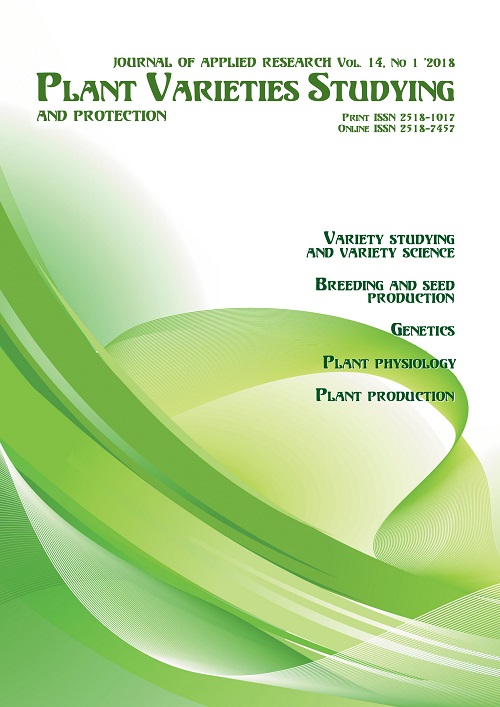Models of corn hybrids of different maturity groups FAO 150–490 for irrigated conditions
DOI:
https://doi.org/10.21498/2518-1017.14.1.2018.126508Keywords:
corn, maize, model, hybrid, irrigation, breeding, yieldAbstract
Purpose. To substantiate morphophysiological and heterozosis models of high yield hybrids of maize FAO 150–490 for irrigation conditions and to create appropriate genotypes with specific adaptability to agroecological factors.
Methods. The general scientific, special selection genetic, computational and comparative research methods were used.
Results. The results of long-term study of maize hybrid models of different maturity groups within the conditions of irrigation are presented. The basic parameters of maize hybrid models of different FAO groups were determined. The parameters of heterozosis models are determined and the lines with high combining ability were created, which are involved in the pedigree of early-ripening, early ripe medium, mid-ripening, middle-late and late groups of maturity of newly created hybrids. The results of the new hybrids response to irrigation methods and regimes are presented. It was found that FAO 190 hybrids have stable yields independently of different irrigation modes. The use of these hybrids is appropriate for the water-saving irrigation modes on irrigated lands with a low groundwater line. Among the middle-hybrids (FAO 300–390) the strong reaction in hybrids growing environmental gradient has appeared. The yield of this hybrids type falls dramatically under water-saving irrigation modes. There were defined corn hybrids of intensive type ‘Arabat’, ‘DN Getera’, ‘DN Anchlag’, ‘DN Rava’ in medium-late hybrid group which provide corn yield of 15–17 t/ha during the drip irrigation and sprinkling irrigation within Ingulets and Kahovsky irrigated lands. There is no practical need to grow this type of hybrids on irrigated lands with a low groundwater line and water-saving condition as far as this type of technology leads to the strong yield loss therefore they become non-competitive with modern FAO 190–290 hybrids.
Conclusions. There new innovative FAO maize hybrids 150–490 were created for irrigated cultivation on the south of Ukraine, which are possessing a complex of economic and valuable features and are able to form high yields during the irrigation (11–17 t/ha). The differentiating ability of the environment within high soil fertility is more than in close-extreme conditions where environmental factors cause a leveling effect on the phenotype’s signs implementation of FAO 400–490 hybrids. The morpho-biological features that determine corn yield are steadily implemented only at high soil fertility. For this reason the phenotype selection is reliable only in favorable conditions. The flexible hybrids adapted to a wide range of external conditions within irrigation’s intensive technologies give way to genotypes productivity with a narrow adaptability.
Downloads
References
FAOSTAT. URL: http://www.fao.org/faostat/en/01.02.2018 #data/QC..
Munsch, M. A., Stamp, P., Christov, N. K., Foueillassar, X. M., Hüsken, A. Camp, K.-H., & Weider, Ch. (2010). Grain Yield Increase and Pollen Containment by Plus-Hybrids Could Improve Acceptance of Transgenic Maize. Crop Sci., 50(3), 909–919. doi: 10.2135/cropsci2009.03.0117
Vozhegova, R. A., Lavrynenko, Yu. O., & Hlushko, T. V. (2014). Productivity of maize hybrids of different FAO groups depending on condition of irrigation and dosage of fertilizers in the southern steppe of Ukraine. Agric. Sci. Pract., 1(3), 62–68. doi: 10.15407/agrisp1.03.062
Troyer, A. F. (2004). Background of U.S. Hybrid Corn II: Breeding, Climate, and Food. Crop Sci., 44(2), 370–380. doi: 10.2135/cropsci2004.3700
Mustyatsa, S. I., & Mistrets, S. I. (2007). Use of the germplasm of heterotic groups BSSS and Reid Ayodent in the selection of early ripen corn. Kukuruza i sorgo [Corn and sorghum], 6, 8–12. [in Russian]
Cherchel, V. Yu., Marochko, V. A., & Tahantsova, M. M. (2014). Argumentation for the index of maize hybrids - the ratio between the height-point of the upper corncob and general plant height (Zea mays L.). Plant Varieties Studying and Protection, 2, 40–44. doi: 10.21498/2518-1017.2(23).2014.56127. [in Ukrainian]
Domashnev, P. P., Dzyubets’kiy, B. V., & Kostyuchenko, V. I. (1992). Selektsiya kukuruzy [Breeding of corn]. Moscow: Agropromizdat. [in Russian]
Ushkarenko, V. A., Lazarev, N. N., Goloborod’ko, S. P., & Kokovikhin, S. V. (2011). Dispersionnyy i korrelyatsionnyy analiz v rastenievodstve i lugovodstve [Dispersion and correlation analyses in plant growing and meadow management]. Moscow: N.p. [in Russian]
Dziubetskyi, B. V., & Cherchel, V. Yu. (2002). Contemporary embryonic plasma in the corn selection program at the Institute of Grain Farming of the UAAS. Selektsia i Nasinnitstvo [Plant Breeding and Seed Production], 86, 11–19. [in Ukraine]
Mikel, M. A. (2011). Genetic composition of contemporary U.S. commercial dent corn germplasm. Crop Sci., 51(2), 592–599. doi: 10.2135/cropsci2010.06.0332
Downloads
Published
How to Cite
Issue
Section
License
Copyright (c) 2018 Ukrainian Institute for Plant Variety Examination

This work is licensed under a Creative Commons Attribution-ShareAlike 4.0 International License.
Starting in 2022, the copyright to the publication remains with the authors
Our journal abides by the CREATIVE COMMONS copyright rights and permissions for open access journals.
Authors, who are published in this journal, agree to the following conditions:
- The authors reserve the right to authorship of the work and pass the first publication right of this work to the journal under the terms of a Creative Commons Attribution License, which allows others to freely distribute the published research with the obligatory reference to the authors of the original work and the first publication of the work in this journal.
- The authors have the right to conclude separate supplement agreements that relate to non-exclusive work distribution in the form in which it has been published by the journal (for example, to upload the work to the online storage of the journal or publish it as part of a monograph), provided that the reference to the first publication of the work in this journal is included.

























 Ukrainian Institute for Plant Varieties Examination
Ukrainian Institute for Plant Varieties Examination  Селекційно-генетичний інститут
Селекційно-генетичний інститут Institute of Plant Physiology and Genetics of the National Academy of Sciences of Ukraine
Institute of Plant Physiology and Genetics of the National Academy of Sciences of Ukraine
 The National Academy of Agrarian Sciences of Ukraine
The National Academy of Agrarian Sciences of Ukraine